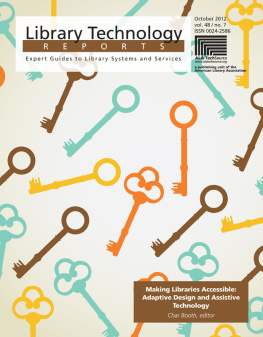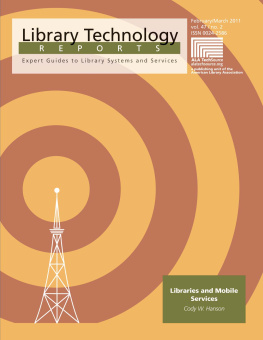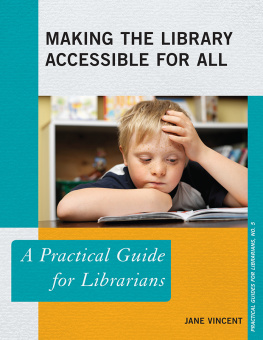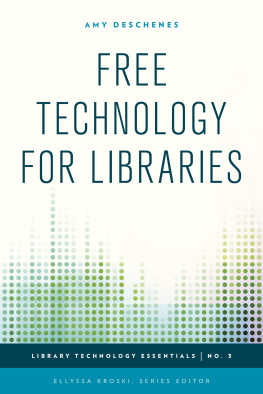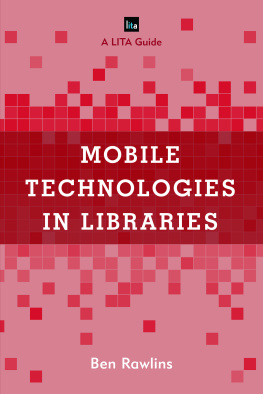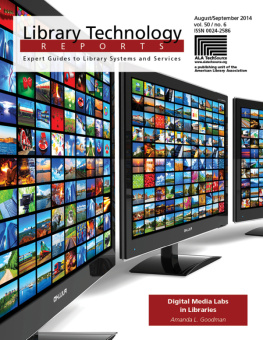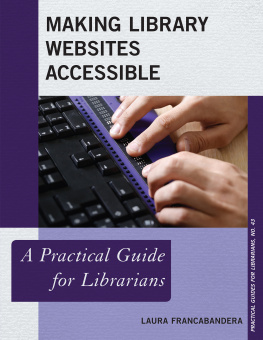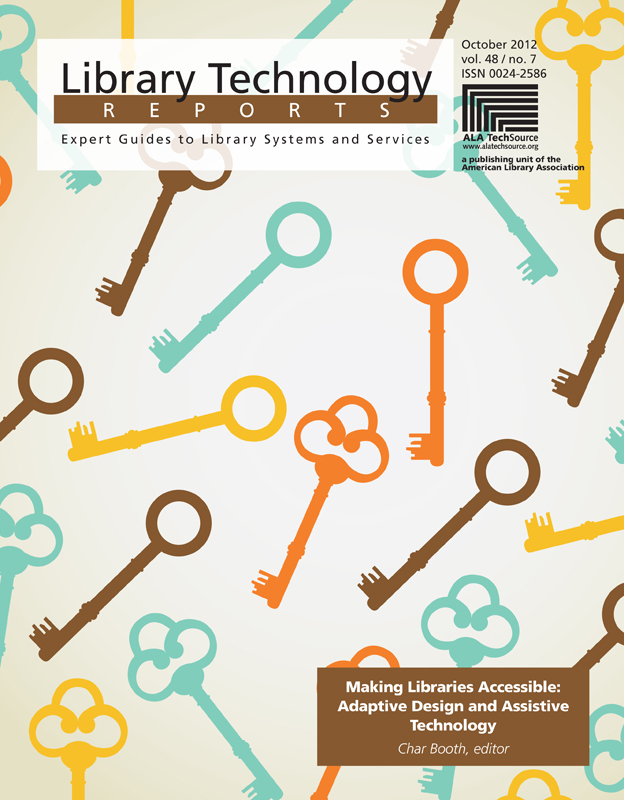
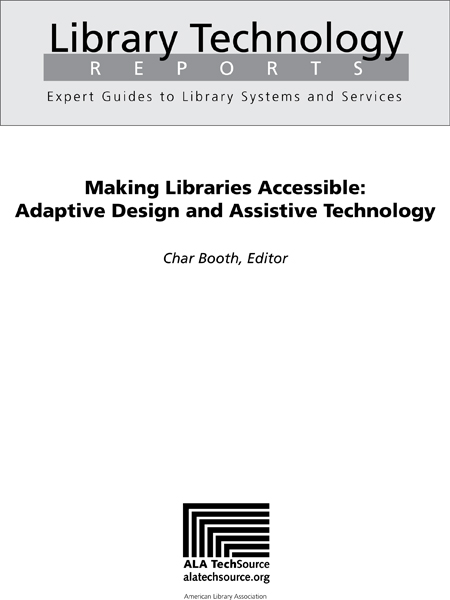
Library Technology Reports
ALA TechSource purchases fund advocacy, awareness, and accreditation programs for library professionals worldwide.
Volume 48, Number 7
Making Libraries Accessible: Adaptive Design and Assistive Technology
ISBNs: (print) 978-0-8389-5862-9; (PDF) 978-0-8389-9441-2; (ePub) 978-0-8389-9442-9; (Kindle) 978-0-8389-9444-3.
American Library Association
50 East Huron St.
Chicago, IL 60611-2795 USA
alatechsource.org
800-545-2433, ext. 4299
312-944-6780
312-280-5275 (fax)
Advertising Representative
Patrick Hogan
312-280-3240
Editor
Patrick Hogan
312-280-3240
Copy Editor
Judith Lauber
Production and Design
Tim Clifford, Production Editor
Karen Sheets de Gracia, Manager of Design and Composition
Library Technology Reports (ISSN 0024-2586) is published eight times a year (January, March, April, June, July, September, October, and December) by American Library Association, 50 E. Huron St., Chicago, IL 60611. It is managed by ALA TechSource, a unit of the publishing department of ALA. Periodical postage paid at Chicago, Illinois, and at additional mailing offices. POSTMASTER: Send address changes to Library Technology Reports, 50 E. Huron St., Chicago, IL 60611.
Trademarked names appear in the text of this journal. Rather than identify or insert a trademark symbol at the appearance of each name, the authors and the American Library Association state that the names are used for editorial purposes exclusively, to the ultimate benefit of the owners of the trademarks. There is absolutely no intention of infringement on the rights of the trademark owners.

alatechsource.org
Copyright 2012 American Library Association
All Rights Reserved.
About the Editor
Early riser, devoted oceanite, and advocate of radical neutrality, Char Booth explores the integration of education, research, technology, and design in libraries. Char is the instruction services manager and e-learning librarian at the Claremont Colleges and is on the faculty of the ACRL Information Literacy Immersion Institute. An ALA Emerging Leader and Library Journal Mover and Shaker, Char blogs at info-mational and tweets @charbooth.
Her publications include Reflective Teaching, Effective Learning: Instructional Literacy for Library Educators (ALA Editions, 2011) and Informing Innovation: Tracking Student Interest in Emerging Library Technologies (ACRL, 2009).
Abstract
Library Technology Reports (vol. 48, no. 7) Making Libraries Accessible: Adaptive Design and Assistive Technology informs readers about how to make libraries digital content, computers, and other devices accessible to people with disabilities. The report presents an overview of demographics, regulations, and types of disability needs as well as associated assistive technology. It also lists and compares specific assistive technology products and assesses accessibility for library collections, including various e-book file formats, e-readers, and databases. Drawing from W3Cs Web Accessibility Guidelines, the report advises on development and design principles for an accessible website.
Get Your Library Technology Reports Online!
Subscribers to ALA TechSources Library Technology Reports can read digital versions, in PDF and HTML formats, through the scholarly content host, MetaPress. Subscribers also have access to an archive of past issues. Visit , if you have any questions about or problems with access.
Subscriptions
alatechsource.org/subscribe
Contents
Char Booth
Barbara T. Mates
Christopher S. Guder
S. G. Ranti Junus
Debra A. Riley-Huff
Jennifer Nastasia Tatomir and Joanna Catarina Tatomir
Char Booth
Why Accessibility?
Char Booth
Abstract
Accessibility, simply defined, means that the fullest use of any resource should be given to the greatest number of people. Libraries, as providers of public space and digital content, have a responsibility to promote equitable access to all users, whether or not they use assistive technology.
Libraries are all about access: to content, to connectivity, and to information education and support. However, there is access, and then there is accessibility. Accessibility is an ethic and set of design approaches that attempt to ensure that the fullest use of any resource is open to the greatest number of people. Physical accessibility facilitates equitable movement in and throughout built spaces. Web accessibility and assistive technology apply this ethic to the innumerable sites, formats, e-readers, and other tools people use to interact with information. Libraries, as purveyors of a vast amount of physical space and digital content, can and should help promote equitable access to all users, whether or not they are disabled.
Awareness of this need is on the rise in libraryland. Our conferences increasingly feature accessibility-themed sessions, our professional groups such as ASCLA offer high-quality Web and in-person programming on a growing range of topics, and the 2010 EQUACC presidential task force featured a prominent e-content accessibility subcommittee. In 2009, the American Library Association formally released a Services to Persons with Disabilities interpretation of the Library Bill of Rights:
The First Amendment to the U.S. Constitution mandates the right of all persons to free expression and the corollary right to receive the constitutionally protected expression of others. A persons right to use the library should not be denied or abridged because of disabilities. The library has the responsibility to provide materials for the interest, information, and enlightenment of all people of the community the library serves. (See also the Library Bill of Rights.) When information in libraries is not presented in formats that are accessible to all users, discriminatory barriers are created.
I would wager that most librarians consider ourselves committed to accessibility and make individual and organizational efforts to comply with or exceed the Americans with Disabilities Act (ADA) guidelines in our physical spaces and Rehabilitation Act Section 508 standards in our digital spaces. We may not, however, have had the sobering experience of trying to access an e-book or e-journal using screen reading software or other assistive technologyan often frustrating and confusing process. (Video examples of screen reader use are provided in .)
Despite our best intentions, this can lead us unwittingly to create barriers that make access more difficult for the disabled. These barriers usually fall into the following categories:
1. Standards. Librarians may lack actionable knowledge of accessibility best practices and standards and may not have meaningful awareness of the disabled user experience.
2. Spaces and services. Libraries may not offer an appropriate range of assistive and adaptive technology tools to serve the needs of their community of disabled patrons, or patrons may lack awareness of the library options that are available to them.
Next page
